Shani G. Radiation Dosimetry: Instrumentation and Methods
Подождите немного. Документ загружается.

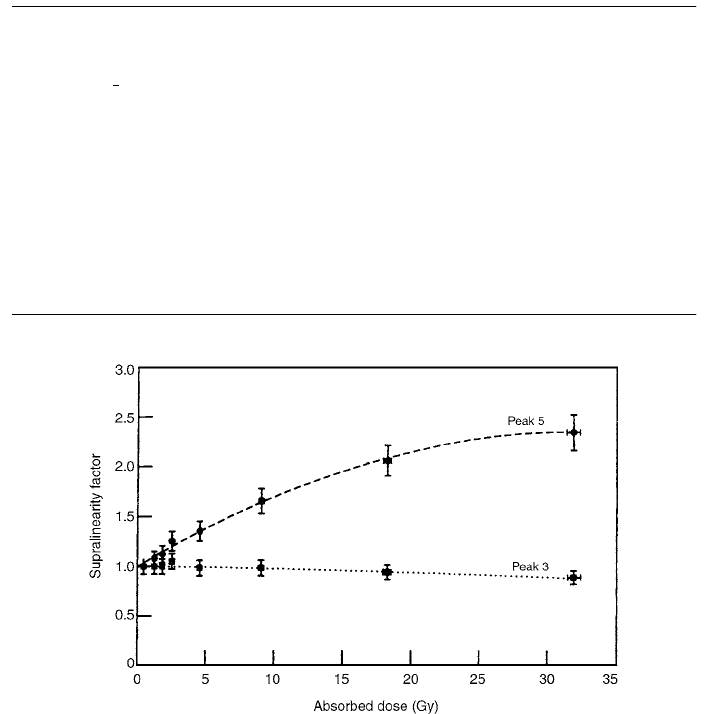
450 Radiation Dosimetry: Instrumentation and Methods
where is the measured TLD response, normalized to
a
60
Co gamma-ray source, for peak v (v 3 or 5), and
and are the neutron sensitivities (for peak v) referring
to the
60
Co gamma-ray and the neutron absorbed dose (in
SS), respectively. is the neutron-kerma ratio between
the TLD-300 and the surrounding material (SS), is the
gamma-ray absorbed dose (in SS), and is the photon
sensitivity of peak v in the mixed n-
field, relative to the
-rays used for calibrating the detectors.
The supralinear zone for peak 5 arises above 2 Gy. A
study of the supralinear behavior of our TLD-300 detec-
tors was carried out and the results are summarized in
Figure 10.37.
Solving Equation 10.42, we get for and :
(10.43)
(10.44)
Values are gathered in Table 10.9.
Dosimetry in a mixed
n-
field was measured by Piters
et al. [29] The measured glow curves were analyzed
according to the glow curve superposition method and
according to the two-peak method. The peak heights were
obtained by fitting the tops of the peaks to a Gaussian
function. Figure 10.38 shows the results of a fit with the
glow curve superposition method. The peaks used for the
two-peak method are indicated by arrows. Corrected and
uncorrected glow curve fits are shown in Figure 10.39. The
temperature shifts and are on the order of 6
C.
The neutron sensitivities of the total response as
well as of separate peaks 3 and 5 on the glow
curve were measured by Angelone et al. [30] for CaF
2
:Tm
(TLD-300) thermoluminescent dosimeters. The TLD-300
were encapsulated in A-150 TE plastic and located at dif-
ferent depths in the water phantom. The neutron sensitivities
TABLE 10.9
Data and Parameters Used to Solve Equations 10.43 and 10.44
Depth
(cm) (MeV) f
5
<k
3
> <k
5
> R
3
(Gy) R
5
(Gy)
2.50 SS 7.40 1.65 1.09 10
–1
3.73 10
–1
9.38 17.75
9.51 SS 3.14 1.21 7.33 10
–2
2.58 10
–1
2.78 3.73
16.52 SS 1.93 1.08 6.24 10
–2
2.22 10
–1
1.09 1.21
23.40 SS 1.43 1.0 5.76 10
–2
2.06 10
–1
4.56 10
–1
4.85 10
–1
The quoted uncertainty is from 6% up to 8% for and from 7% up to 12% for .
Source: From Reference [28]. With permission.
FIGURE 10.37 Measured supralinearity factor for peak 3 and peak 5 of TLD-300 plotted against absorbed dose (Gy). (From
Reference [28]. With permission.)
E
n
R
3
R
5
f
v
()
R
v
k
v
D
n
C
n
D
h
v
D
D
n
D
R
5
k
5
k
3
-----
R
3
f
5
f
3
k
5
k
3
-----
------------------------------
D
n
f
5
R
3
f
3
R
5
()
C
n
f
5
k
3
f
3
k
5
()
----------------------------------------
dT
a
dT
b
k
T
()
k
3
() k
5
()
Ch-10.fm Page 450 Friday, November 10, 2000 12:04 PM
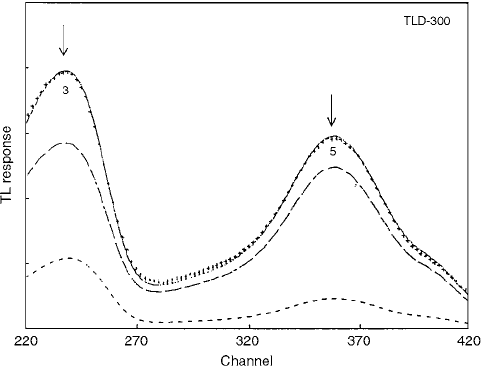
Neutron Dosimetry 451
of the TLDs were derived by comparison with the results
obtained with the twin detector method.
It is possible to use TLD-300 to separate the neutron
and gamma dose, even for a complex neutron spectrum,
provided that the neutron sensitivities of peak 3 and peak
5 are obtained by a proper weighting procedure of the
monoenergetic data, using the calculated neutron spectra
as weighting functions. This method requires the neutron
spectrum to be known, and it is applicable for neutron
energies lower than 25 MeV, since above this energy no
data for the neutron sensitivity of TLD-300 are available.
TLD-300 shows a typical glow curve characterized
by two main peaks, designated as peak 3 and peak 5
(Figure 10.40). The two peaks show different responses
to different LET particles.
Angelone et al. found that there is a linear relationship
between the ratio of the area under peak 3 to that under
peak 5 (A
3
A
5
) and the ratio of the gamma dose to the
total dose (D
y
D
T
) (Figure 10.41).
Thermal neutron responses (TNR) of some thermolu-
minescence dosimeters (TLDs) were investigated by Mat-
sumoto [31] for the application mixed-field dosimetry of
thermal neutrons and gamma-rays. The TNR values of
Mg
2
SiO
4
:Tb (MSO-S) and Mg
2
SiO
4
:TbLiF (MSO-LiF)
elements were determined to be 3 mGy and 2.9 Gy, respec-
tively, for a thermal neutron fluence of 10
10
n cm
2
.
Figure 10.42 shows the relationship between the ther-
mal neutron fluence and the TLD response. It is clear that
TL materials having large cross sections, such as boron,
lithium and gadolinium, are capable of a large thermal neu-
tron response. However, Mg
2
SiO
4
:Tb and BeO also have
small responses for thermal neutrons.
V. SUPERHEATED DROP NEUTRON
DOSIMETER
The superheated drop detector (SDD) consists of thousands
of superheated drops dispersed in a small vial of gel which
vaporize upon exposure to high LET radiation, thereby
providing a directly observable indication of neutron dose.
This detector possesses high sensitivity to neutrons and
insensitivity to high-energy photons and electrons, making
it suitable for the determination of neutron dose-equivalent
rates around high-energy photon and electron radiotherapy
beams.
The principle of a bubble dosimeter is the following.
A great number of very small droplets of a liquid with a
low heat of vaporization are incorporated into an organic
gel or polymer. For a specific temperature and pressure,
the liquid droplets are superheated in a metastable state.
This unstable equilibrium can be destroyed by an external
energy supply.
At the interaction point between droplet and high
LET particle, such as a neutron or heavy charged
particle, the liquid droplet becomes vaporized as a
visible gas bubble. The overall absorbed dose is cor-
related to the number of bubbles. If the gel viscosity
is low, bubbles can reach the surface and increase the
upper gas volume. The corresponding dose can be
derived by measuring the gas volume thus produced
with a simple optical scaling system. A sound is emit-
ted for each bubble being created and the bubbles are
counted in real time by an electro-acoustic transducer
(Figure 10.43). The dose rate corresponds to bubble
frequency.
FIGURE 10.38 Glow curve of TLD-300 () after an irradiation in a mixed (n,
) radiation field with actual dose D
10 mGy
and . The composed glow curve (solid line) is a superposition of the calibration curves multiplied
by
A 0.085 (dotted curve) and multiplied by B 0.32 (broken curve). The arrows indicate the peaks used in the two-peak
method. Results for superposition method: , . Results for the two-peak method: ,
. (From Reference [29]. With permission.)
D
n
92 mGy
E
n
6 MeV() I
a
I
b
D
9.4 mGy D
n
92 mGy D
9.6 mGy
D
n
91mGy
Ch-10.fm Page 451 Friday, November 10, 2000 12:04 PM
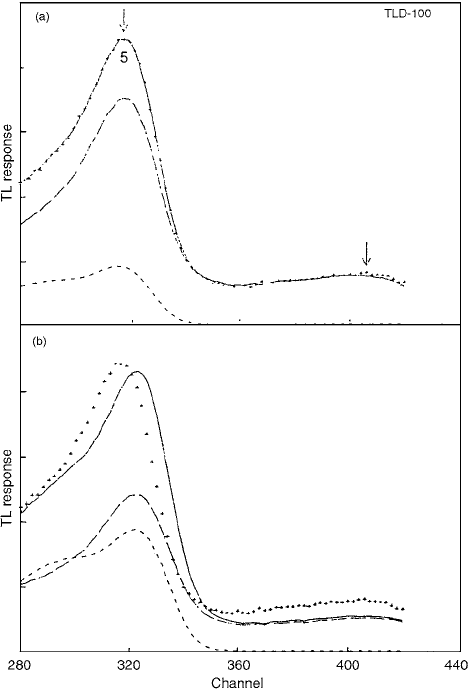
452 Radiation Dosimetry: Instrumentation and Methods
Bubble dosimeters generally have low sensitivity to
photon radiation.
The superheated drop detector (SDD), invented by
Apfel et al. [32], consists of a collection of superheated
drops suspended in a gel. Its operation is based on the
same principle as that of the bubble chamber, namely, the
initiation of vapor bubbles by energetic ions in super-
heated liquids. The volume of vapor or the acoustic waves
given out when superheated drops vaporize serve as a
measure of neutron exposure. Since the drops are kept in
a “perfectly smooth” container, i.e., another liquid, the
sample can be maintained in a superheated state for a long
period of time. The repressurization procedure needed in
the conventional bubble chamber is avoided, and when
one drop boils explosively, it does not trigger boiling in
adjacent drops. Therefore, each drop in the SDD is a
continuously sensitive miniature bubble chamber. It rep-
resents stored mechanical energy which is released when
triggered by radiation. The operation of the SDD does not
require any power source. Using appropriate materials, it
can operate at room temperature and have a near dose-
equivalent response. Direct readability, simplicity of prep-
aration, and low cost make it potentially useful in the
measurement of neutron dose-equivalence for patients
undergoing high-energy x-ray or electron radiotherapy.
The elemental composition of an SDD by weight is
9.6% hydrogen, 23.4% carbon, 66.3% oxygen, 0.24%
fluorine, and 0.46% chlorine, and its physical density is
1.14 g cm
3
, very similar to that of tissue-equivalent liquid
used in neutron dosimetry.
The SDD is available in several forms, from a pen
dosimeter to an electronic bubble event counter. The
detector employed by Nath et al. [33] was a 4-cm
3
glass
vial filled with a gel into which approximately 20,000
drops were mixed. Each drop was about 65
m in diameter
and upon vaporization expanded to about 500
m. The
superheated drop material was a halocarbon (CCI
2
F
2
), oth-
erwise known as Freon 12.
A graduated pipette was fitted onto the vial cap to read
the gel volume displaced by neutron-induced bubbles.
After screwing the cap fitted with the pipette to the vial,
the vials were inverted to trap the rising bubbles in the gel
and prevent them from rising to the surface and escaping
through the indicator pipette, thereby causing erroneous
volume readings.
The neutron dose equivalent vs. volume relationship
was fitted by least squares with an equation of the form:
(10.45)
where and are the fitting parameters determined
from absolute calibration. The calibration curve was linear
up to 5.0 mSv (500 mrem), with a cumulative maximum
usable dose equivalent of about 50 mSv (5000 mrem).
The sound produced by bubble formation was
recorded by transducers that sense the accompanying pres-
sure pulse. The active survey meter (ASM) electronically
discriminates against spurious noise and vibration. Several
devices based on the technology described have been
designed. Some are active counters acoustically detecting
the sound pulses emitted when drops vaporize. Recent
versions perform pulse shape analysis, record the exposure
time history, and provide dose rate estimates. Others are
passive, integrating meters typically employed in person-
nel monitoring. Two types of passive dosimeters exist:
they are based either on the optical counting of the bub-
bles, which are permanently trapped in a stiff polymer
matrix, or on the measurement of their total volume, which
is, in this case, inferred from the expansion of a soft gel
they are dispersed in.
FIGURE 10.39 Glow curve of TLD-100 () irradiated in a mixed
(
,n) radiation field. and (1
MeV) analyzed (a) with and (b) without corrections in the heating
profiles of the calibration curves.
The dolled and broken curves
are
the contributions of the calibration curves and to the
total glow curve (solid line). Results for (a): ,
. Results for (b): ,
D
n
. (From Reference [29]. With permission.)
D
3.5 mGy D
n
98.5 mGy
I
a
I
b
D
3.6 mGy
D
n
92.7 mGy
D
4.8 mGy
63.7 mGv
Dose Equivalent(mSv) c
1
1 volume(cm)
3
c
2
()ln
c
1
c
2
Ch-10.fm Page 452 Friday, November 10, 2000 12:04 PM
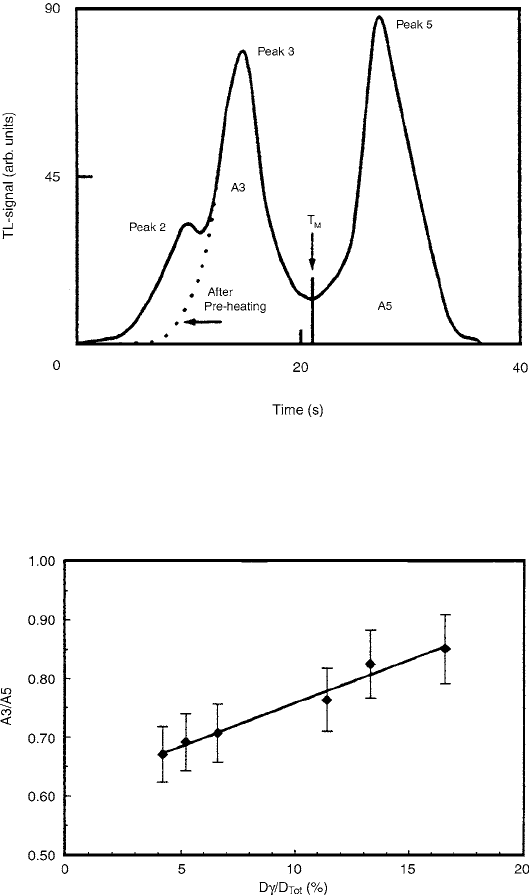
Neutron Dosimetry 453
The approach of D’Errico et al [34] relies on a triplet
of the passive, volumetric emulsions having different
degrees of superheat. These permit the detection of neu-
trons above distinct energy thresholds and provide a three-
bin energy spectrum as well as an estimate of the total
neutron dose equivalent.
Three halocarbons were chosen by d’Errico et al.:
dichlorotetrafluorocethane (R-114), octafluorocyclobli-
tane (C-318), and dichlorofluoromethane (R-12). At 30C,
the selected operating temperature, R-12 emulsions
respond from thermal to fast neutrons while R-114 and
C-318 present effective energy thresholds of 1.0 and 5.5
MeV, respectively. At 30C, all these emulsions are insen-
sitive to
-and x-rays, at least below the energy thresholds
for photo-nuclear reactions—generally around 15 MeV
for the low-Z detector constituents.
In order to avoid saturation effects due to the intense and
pulsed nature of the radiation field, passive custom-made
superheated emulsions (SE) with volumetric readout were
employed in the photo-neutron measurements. The dosime-
ters consist of 4.5-ml vials (14-mm inner diameter, 30-mm
height) connected to graduated pipettes (Figure 10.44). The
bottom 1.5 ml of each vial is the active part filled with
neutron-sensitive emulsion, i.e., tens of thousands of
60-
m droplets suspended in a glycerin-based gel, while
the top contains inert gel only. When vapor bubbles form,
they displace a commensurate volume of gel into the pipette,
thus providing an immediate, though passive, response. [34]
FIGURE 10.40 TL signal vs. reading time for TLD-300 irradiated with neutrons. The three main peaks before and after the preheating
cycle are shown. The two areas corresponding to peak 3 and peak 5 under the glow curve are separated at
T
M
, the time at which the
minimum between the two peaks occurs. (From Reference [30]. With permission).
FIGURE 10.41 Plot of the area ratio of peaks 3 and 5 vs. the measured (D
y
/D
T
) ratio. (From Reference [30]. With permission.)
Ch-10.fm Page 453 Friday, November 10, 2000 12:04 PM
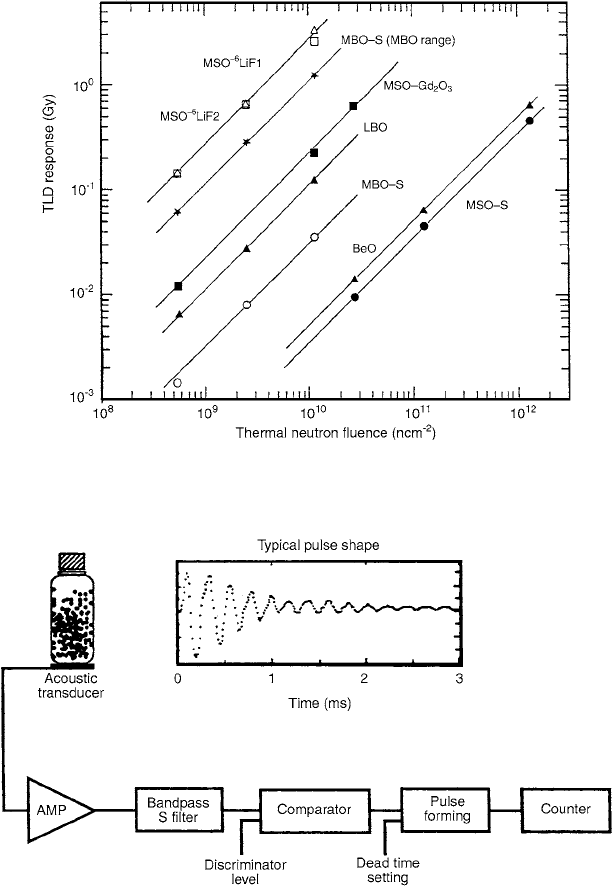
454 Radiation Dosimetry: Instrumentation and Methods
The detection efficiency, or fluence response (number
of bubbles per incident neutron per square centimeter), of
all SE types as a function of operating temperature and
neutron energy was determined with electronic instrumen-
tation recording the drop vaporization events acoustically.
Active bubble counting was possible in low-intensity
metrology fields and was chosen for the calibrations since
it allows for higher precision compared to the passive
volumetric readout.
The relative fluence responses of the three emulsions
used in this study are shown in Figure 10.45, plotted as
a function of neutron energy. These curves present
thresholds corresponding to the minimum neutron ener-
gies that can trigger the nucleation. The general rule
they reflect is that the higher the superheat of the
liquid, the lower the minimum energy that neutrons, or
rather their charged secondaries, must impart to the drops
in order to nucleate their evaporation. In particular, the
emulsions of halocarbons C-318 and R-114 require
the deposition of hundreds of keV per micrometer and are
nucleated only by fast neutrons, via the recoils generated
inside or next to the superheated drops. In fact, bubble
nucleation occurs only when sufficient energy is depos-
ited within an extremely localized region of the super-
heated drop. While charged recoils generate trails of
microscopic vapor cavities inside the droplets, only
those exceeding a minimum critical size can develop
into macroscopic bubbles. When this size is reached,
FIGURE 10.42 Relationship between TLD response and thermal neutron fluence. (From Reference [31]. With permission.)
FIGURE 10.43 Principle of the electro-acoustic bubble dosimeter. (From Reference [17]. With permission.)
Ch-10.fm Page 454 Friday, November 10, 2000 12:04 PM
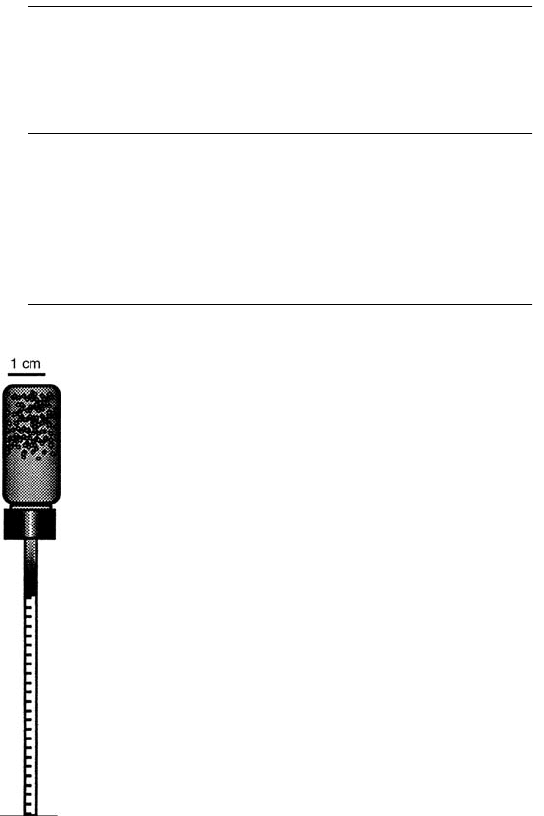
Neutron Dosimetry 455
the expansion becomes irreversible and the whole drop-
let evaporates.
Figure 10.45 shows that emulsions of halocarbon
R-12 (CCl
2
F
2
) are also sensitive to thermal and interme-
diate neutrons. This occurs as the droplets contain chlorine
and are sufficiently superheated to be vaporized by the
exoergic
35
Cl(n,p)
35
S capture reaction, which releases 615
keV and creates densely ionizing 17-keV sulfur ions.
Although R-l 14 (C
2
Cl
2
F
2
) has two chlorine nuclei in its
molecule, it is not superheated enough to be nucleated by
the energy deposition pattern of the reaction products.
Thus, neither R-l 14 nor C-318 (C
4
F
8
) emulsions are sen-
sitive to thermal neutrons in the temperature range of
interest, as was verified at the PTB reactor. [34]
The normalized experimental and calculated fluence
response curve for R-12 is plotted in Figure 10.45 against
the “kerma-equivalent-factor” . The latter is the aver-
age tissue kerma per unit neutron fluence weighted by the
quality factor (
QF) of the neutron secondary particles.
Neutron dose-equivalent measurements were per-
formed by Loye et al. [35] in and around an 18-MV x-ray
beam using superheated drop detectors and phosphorous
pentoxide (P
2
O
5
) powder. The neutron capture reaction
31
P(n,
)
32
P is significant only for thermal neutrons, and
the
31
P(n, p)
31
S reaction is sensitive to fast neutrons above
0.7 MeV. The activation products
31
Si and
32
P are pure
emitters with half-lives of 2.62 h and 14.28 d, respectively.
Five ml of a solution of 0.32 gm of P
2
O
5
powder per ml
of distilled water were placed in each scintillation vial.
The samples were irradiated with approximately 40 Gy of
x-ray dose. Two ml of solution from each of the irradiated
vials were transferred to fresh scintillation vials, and 15 ml
of the liquid scintillation counter (LSC) cocktail Insta-gel
Plus™ were added to each of these vials. The vials were
counted for 1 min each, 8–10 times, and were corrected
for decay between counts.
32
P activity for the thermal
neutrons was measured the next day after sufficient decay
of
31
Si.
The superheated drop detectors used were Neutrom-
eter-HD™ (SDD 100) purchased from Apfel Enterprises,
Inc. The response of these detectors is dose-equivalent
from thermal-energy (0.025 eV) to fast-energy (66 MeV)
neutrons. Each detector has thousands of droplets (approx-
imately 20,000) of Freon 12 suspended in a gel contained
in a 4-cm
3
vial.
The drops expand from roughly 65 to 500
m and the
expansion of the bubbles displaces the gel into the pipette.
The volume displaced is equated with dose equivalence
(DE) by Equation 10.45. For the detectors used by Loye
et al, equals 28.5 and equals 0.685, as calibrated
by Apfel Enterprises, Inc.
Seitz’s theory [36] suggests that when a heavy charged
particle slows down moving through a liquid, its kinetic
energy is transferred as thermal energy to extreme small
regions (temperature spikes) through the intermediarv of
rays. The intense heating induces localized boiling,
TABLE 10.10
Chemo-Physical Data for Superheated Emulsions ICRU-
Recommended TE Composition and TE Liquid
Elemental composition by weight percent
Density
Material H C O N F, Cl (g cm
–3
)
SE 8.8 28.2 62.5 ... 0.5 1.2
ICRU TE 10.1 11.1 76.2 2.6 ... 1.0
TE liquid 10.2 11.1 76.1 2.6 ... 1.1
From Reference [34]. With permission.
FIGURE 10.44 Passive, integrating superheated drop (bubble)
detector with volumetric readout for the measurement of high
neutron dose rates. (From Reference [34]. With permission.)
k
f
Q
n
C
1
C
2
Ch-10.fm Page 455 Friday, November 10, 2000 12:04 PM
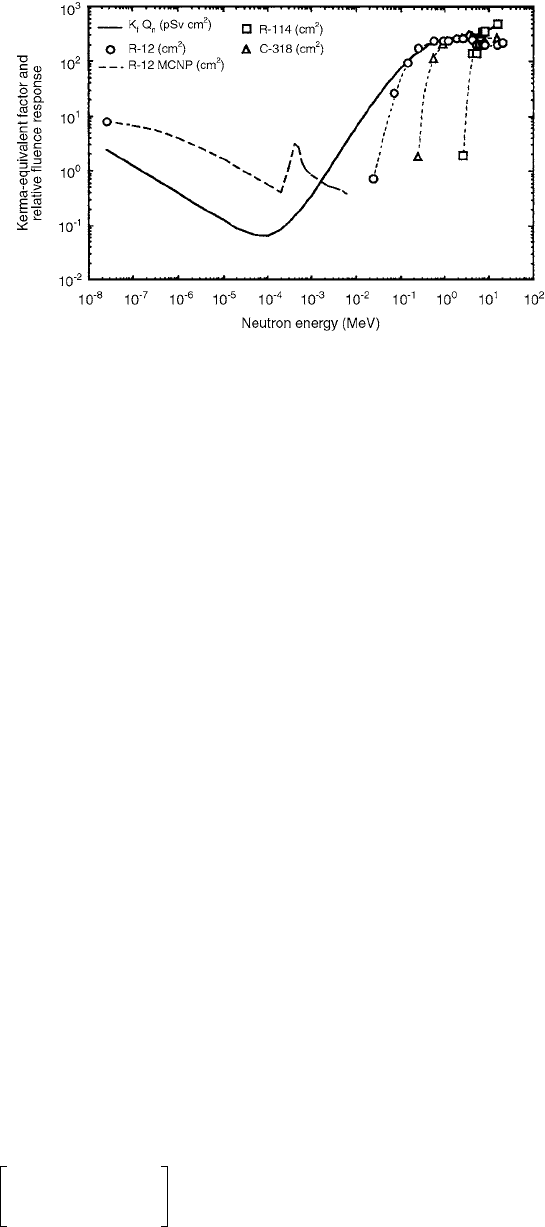
456 Radiation Dosimetry: Instrumentation and Methods
creating trails of microscopic vapor cavities which
develop into macroscopic bubbles when the density of
energy deposition is high enough. It is assumed that a
spherical vapor cavity of radius r, embedded in a liquid
of surface tension
and vapor tension , expands indef-
initely when , where is external pres-
sure. Therefore, a critical radius defines the
discriminator between growing bubbles and those collaps-
ing under the action of external forces. Various expres-
sions of the formation energy for such critical bubbles
have been proposed, such as: [37]
where is vapor density, is liquid density, is
latent table heat of vaporization, is vapor wall velocity,
is the minimum reversible work required for bub-
ble formation or Gibbs free energy,
H is the vaporization
energy, is the kinetic energy imparted to the liquid
by the motion of the vapor wall, and F is the energy
imparted to the liquid during the growth of the bubble by
the viscous forces. Neglecting the last two terms and sub-
stituting for :
(10.47)
where R
*
is the gas constant. It may be immediately
observed that when the degree of superheat p increases,
both the critical radius and the minimum formation
energy decrease. Values of
k between 1 and 13 have been
proposed for the expression E
min
kr
c
(dEdx). Although
this semi-empirical approach allows for an estimate of
the measured bubble formation energy in superheated
liquids, it is far from reflecting the physics of the bubble
nucleation.
The flow fields, as a function of time t and radial
distance r, of a viscous, heat-conducting, and compress-
ible fluid subject to the singular initial condition of a
sudden energy deposition are then governed by five fluid
dynamic equations: three conservation equations (mass,
momentum, and energy), one equation of state, and its
associated specific internal energy equation (treating the
medium as a Horvath-Lin fluid). These are sufficient to
solve for the five unknowns: temperature, T; pressure, p;
velocity, u; specific volume, v; (density
l/v); and
specific internal energy, e. It is noteworthy that a critical
radius equal to 2/3 of Seitz’s had already been shown to
improve consistency with the experimental findings. [37]
The correlation existing between density of energy trans-
fer and efficiency of radiation-induced vaporization was
examined by d’Errico et al. [38] by determining the response
to thermal neutrons of dichlorofluoromethane (CCl
2
F
2
) emul-
sions as a function of temperature. These emulsions contain
35
Cl that undergoes the exoergic capture reaction
35
Cl(n, p)
35
S
with low-energy neutrons. Of the reaction products, the pro-
ton receives 598 keV and deposits it over 13
m, a relatively
long range compared to the critical radius, whereas the sul-
phur ion receives 17 keV and deposits it within 43 nm.
Measurements carried out at carefully controlled tem-
peratures between 10C and 40C showed that the sensitiv-
ity to thermal neutrons is thermodynamically inhibited
below 15C, while it rises sharply above 22C (Figure
10.46). The responses of octafluorocyclobutane (C
4
F
8
)
and dichlorotetrafluoroethane (C
2
Cl
2
F
2
) are shown in
FIGURE 10.45 Kerma equivalent factor, , plotted as a function of neutron energy vs. the relative fluence responses of the
superheated emulsions (all normalized to the kerma factor plateau): R-12 (O, experimental, and —,calculated), C-318 (
), and R-
l14 (
). (From Reference [34]. With permission.)
k
f
Q
n
p
v
p
v
p
e
()2
r p
e
r
c
2
p
W 4
r
c
2
4
3
---
r
c
3
p
4
3
---
r
c
3
v
h
fg
2
1
r
c
3
r˙
2
F
W
Gibbs
HE
wall
F (10.46)
v
1
h
fg
r
˙
W
Gibbs
E
wall
r
c
2
p
W
16
3
3 p
2
----------------
1
2p
v
p
--------
1
h
fg
R
*
T
----------
Ch-10.fm Page 456 Friday, November 10, 2000 12:04 PM
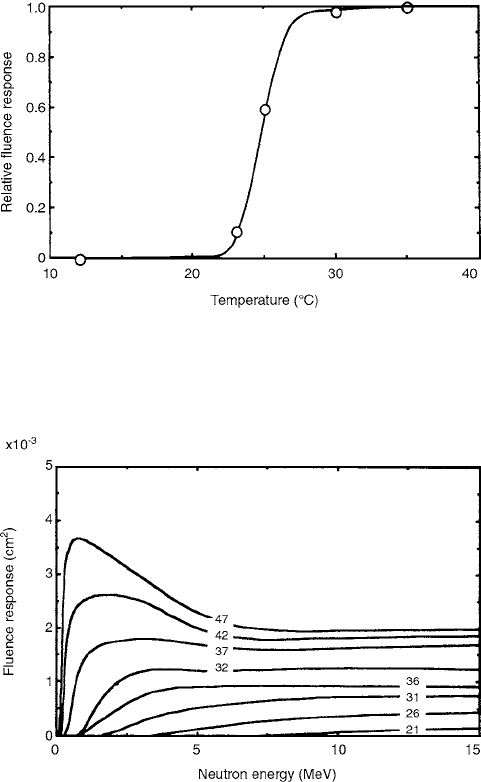
Neutron Dosimetry 457
Figure 10.47: two sets of four curves are reported, each one
identified by the corresponding degree of superheat
T
(expressed in Kelvin above the boiling temperature). It is
evident that the higher the superheat, the lower the energy
that neutron-charged secondaries must impart to the drop-
lets in order to nucleate their evaporation.
Figure 10.47 also documents the progressive appear-
ance of a maximum in the response of highly superheated
emulsions. This is correlated with the arising detection
efficiency for neutron-recoiled protons entering the drops
from the surrounding hydrogenated gel.
Design of neutron dosimeters based on superheated
drop (bubble) detectors was described by d’Errico et al.
[38] Designs rely on the double transducer scheme but
adopt a comparative pulse-shape analysis of the signals.
Pulses from the two piezoelectric transducers are amplified
and fed to rectifier detectors producing their envelopes,
which are then processed by analog/digital converters
(Figure 10.48). When the signal from the SDD vial
exceeds an adjustable threshold and presents the typical
decay pattern of a bubble pulse, the two digitized tracks
are compared. The detector pulse is accepted only when
its shape clearly differs from the signal in the noise
channel.
In order to minimize the temperature dependence of
the response, an effective and elegant solution was pro-
posed and is now implemented in passive devices. In a
sealed vial, a low-boiling-point liquid is introduced over
the free surface of the sensitive emulsion (Figure 10.49).
The vapor tension of this liquid varies with ambient tem-
perature, and the pressure thus applied to the detector
compensates for the temperature effects. In fact, the neu-
tron detection efficiency depends on the overall degree
of superheat of the emulsion, i.e., on the combination of
pressure and temperature values. The dependence on
these quantities is illustrated in Figure 10.50, showing
FIGURE 10.46 Relative fluence response of a dichlorofluoromethane emulsion to thermal neutrons as a function of operating
temperature. (From Reference [37]. With permission.)
FIGURE 10.47 Fluence response of octafluorocyclobutane (left-hand side) and dichloroletrafluoroethane (right-hand side) emulsions
as a function of degree of superheat (reported on each curve) and neutron energy. (From Reference [37]. With permission.)
Ch-10.fm Page 457 Friday, November 10, 2000 12:04 PM
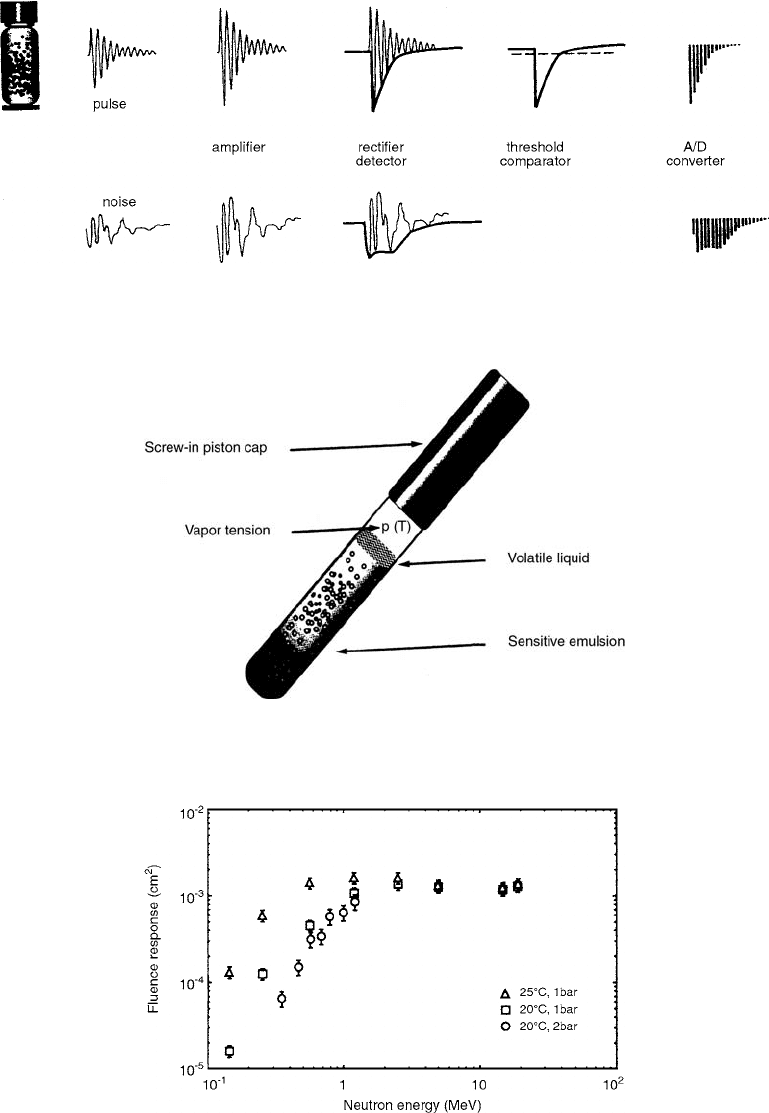
458 Radiation Dosimetry: Instrumentation and Methods
that the increase in response of a dichlorofluoromethane
detector warmed up from 20 to 25C is almost exactly
counterbalanced by raising the operating pressure from
1 to 2 bar. In dosimeters with pressure compensation, the
variation of sensitivity per degree Celsius is reduced from
5 to about 1%.
A Radiation Assessment Instrument for Space Appli-
cations (RAISA) based on bubble detectors has been
FIGURE 10.48 Schematic of an active bubble counter based on the acoustical recording of bubble vaporizations. (From Reference
[38]. With permission.)
FIGURE 10.49 Passive bubble detector with re-pressurization cap and temperature compensation system. (From Reference [38].
With permission.)
FIGURE 10.50 Fluence response of a dichlorofluoromethane emulsion as a function of pressure, temperature, and neutron energy.
(From Reference [38]. With permission.)
Ch-10.fm Page 458 Friday, November 10, 2000 12:04 PM
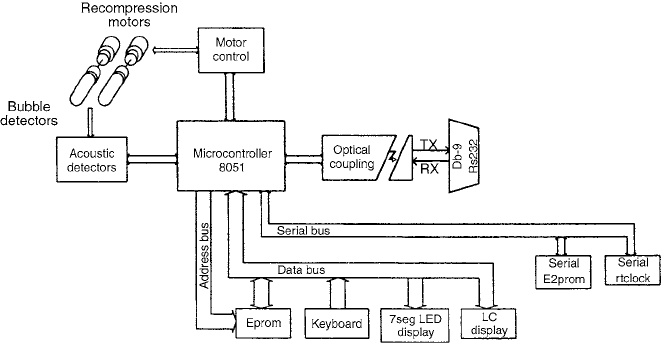
Neutron Dosimetry 459
developed by Ing et al. [40] to meet the needs for radiation
monitoring for long-term space missions. RAISA uses two
bubble detectors, but at any time only one of the detectors
is used as the radiation sensor. When a maximum number
of bubbles has accumulated in this detector, a micropro-
cessor turns on the second detector and recompresses the
first detector. In addition to instantaneous display of ambi-
ent dose rate, RAISA records information in memory
every second.
Measurements of space radiation with bubble detec-
tors have been done using specially formulated BD-PNDs.
Although the BD-PND can be packaged so that its con-
tents remain unchanged (chemically and physically) for
many years, this detector cannot be used continuously for
years since the number of bubbles continues to accumulate
with radiation exposure and the detector can accommo-
date only a maximum number of bubbles before filling the
entire detector. Thus, it is necessary that the bubbles be
recompressed (or “cleared”) once a specified number of
bubbles (say, 300) has accumulated. Also, it is generally
desirable to clear the bubbles after a certain period of time
because the accumulated bubbles continue to grow (very
slowly) after their initial formation and oversize bubbles
are more difficult to recompress. For normal applications,
the bubble detector is recycled (i.e., read and recom-
pressed) every few days during use. The reading is usually
done with an automatic reader which counts the total
number of bubbles in the detector using sophisticated
image-processing software.
Figure 10.51 shows a block diagram of all the compo-
nents that make up RAISA. The acoustic detectors provide
bubble-explosion detection and external-noise sensing to
ensure that no external noise can be mistaken as a bubble
explosion. The acoustic bubble detectors consist of piezo-
electric sensors, charge-sensitive preamplifiers, analog
switches for selecting bubble detectors, level comparators,
and output timers. Serial Eprom is a non-volatile memory
capable of storing up to 15,700 bubble events; this infor-
mation includes the time at which the bubble event was
recorded. This data can be retrieved using any computer
via serial communication.
The properties of neutron bubble detectors (type BD-
100 R
*
) have been investigated by Schulze et al. [41] with
fast neutrons from D-T and Am-Be sources. The experi-
mentally determined responses of the bubble detectors
have shown considerable fluctuations (up to 50%). The
response after repeated recompressions has been exam-
ined. The detectors proved to be insensitive to gammas.
The bubble detectors (type BD-100 R) consist of a
small test tube (overall length 80 mm, active length 45 mm,
diameter 15 mm) filled with an elastic clear polymer. Inter-
spersed in this polymer are superheated freon droplets.
Recoil protons may be produced by neutron interaction with
the polymer. If these protons strike such a droplet, it may
vaporize. This vaporized droplet remains trapped as a
visible bubble in the polymer. Recharging is accom-
plished by pressurizing the bubble detectors considerably
above the vapor pressure of the freon gas mixture, thereby
reforming the bubbles to liquid droplets.
Figure 10.52 shows the deviation of the dose equiva-
lent measured with the bubble detectors as a function of
the recompression cycles. The values from bubble detec-
tors of the two low-sensitivity classes, as well as of the
two high-sensitivity classes, were combined for greater
clarity. In particular, the bubble detectors of the low-sen-
sitivity classes showed large deviations when used for the
first time and the reading was significantly too high
(mean
150%). After the third recompression (i.e., the
fourth irradiation), all bubble detectors showed a 40% to
50% higher dose equivalent than that applied, but the
variations were still large.
Superheated drop compositions have been employed
by Apfel et al. [42] in two passive (non-electronic) direct
reading detectors for neutron monitoring of personnel
FIGURE 10.51 Block diagram of main components of RAISA. (From Reference [40]. With permission.)
Ch-10.fm Page 459 Friday, November 10, 2000 12:04 PM
